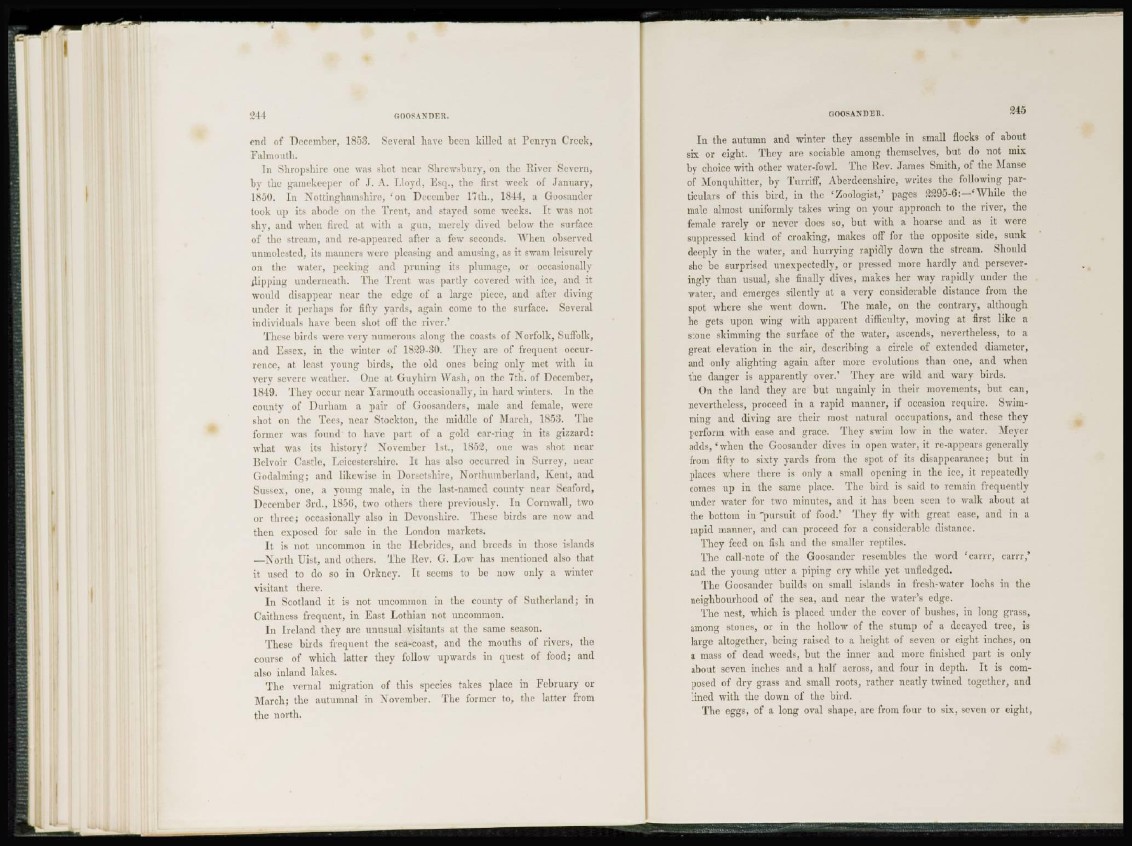
GOOSANDER.
ond of December, 1853. Several have been hilled at Pcnryn Creek,
Falmouth.
In Shropshire one was shot near Shrewsbury, on the River Severn,
by the gamekeeper of J. A. Lloyd, Esq., the first week of January,
1850. In Nottinghamshire, ' on December 17th., 1844, a Goosander
took up its abode on the Trent, and stayed some weeks. It was not
shy, and when fired at with a gun, merely dived below the surface
of the stream, and re-appeared after a few seconds. "When observed
unmolested, its manners were pleasing and amusing, as it swam leisurely
on the water, pecking and pruning its plumage, or occasionally
{lipping underneath. The Trent was partly covered with ice, and it
would disappear near the edge of a large piece, and after diving
under it perhaps for fifty yards, again come to the surface. Several
individuals have been shot off the river.'
These birds were very numerous along the coasts of Norfolk, Suffolk,
and Essex, in the winter of 1829-30. They are of frequent occurrence,
at least young birds, the old ones being only met with in
very severe weather. One at Guyhirn Wash, on the 7th. of December,
1849. They occur near Yarmouth occasionally, in hard winters. In the
county of Durham a pair of Goosanders, male and female, were
shot on the Tees, near Stockton, the middle of March, 1853. The
former was found to have part of a gold car-ring in its gizzard:
wdrat was its history.' November 1st., 1852, one was shot near
Bclvoir Castle, Leicestershire. It has also occurred in Surrey, near
Godalming; and likewise in Dorsetshire, Northumberland, Ivent, and
Sussex, one, a young male, in the last-named county near Seafbrd,
December 3rd., 1850, two others there previously. In Cornwall, two
or three; occasionally also in Devonshire. These birds are now and
then exposed for sale in the London markets.
I t is not uncommon in the Hebrides, and breeds in those islands
—N o r t h Ui-st, and others. The Rev. G. Low has mentioned also that
it used to do so in Orkney. It seems to be now only a winter
visitant there.
I n Scotland it is not uncommon in the county of Sutherland; in
Caithness frequent, in East Lothian not uncommon.
I n Ireland they are unusual visitants at the same season.
These birds frequent the sea-coast, and the mouths of rivers, the
course of which latter they follow upwards in quest of food; and
also inland lakes.
The vernal migration of this species takes place in February or
March; the autumnal in November. The former to, the latter from
the north.
GOOSANDER. 2 15
I n the autumn and winter they assemble in small flocks of about
six or eight. They are sociable among themselves, but do not mix
by choice with other water-fowl. The Rev. James Smith, of the Manse
of Monquhitter, by Turriff, Aberdeenshire, writes the following particulars
of this bird, in the 'Zoologist,7 pages 2295-6:—'While the
male almost uniformly takes wing on your approach to the river, the
female rarely or never does so, but with a hoarse and as it were
suppressed kind of croaking, makes off for the opposite side, sunk
deeply in the water, and hurrying rapidly down the stream. Should
she be surprised unexpectedly, or pressed more hardly and perseveringly
than usual, she finally dives, makes her way rapidly under the
water, and emerges silently at a very considerable distance from the
spot where she went down. The male, on the contrary, although
he gets upon wing with apparent, difficulty, moving at first like a
stone skimming the surface of the water, ascends, nevertheless, to a
great elevation in the air, describing a circle of extended diameter,
and only alighting again after more evolutions than one, and when
the danger is apparently over.' They arc wild and wary birds.
On the land they arc but ungainly in their movements, but can,
nevertheless, proceed in a rapid manner, if occasion require. Swimming
and diving arc their most natural occupations, and these they
perform with ease and grace. They swim low in the water. Meyer
adds, 'when the Goosander dives in open water, it re-appears generally
from fifty to sixty yards from the spot of its disappearance; but in
places where there is only a small opening in the ice, it repeatedly
comes up in the same place. The bird is said to remain frequently
under water for two minutes, and it has been seen to walk about at
the bottom in "pursuit of food.' They fly with great ease, and in a
rapid manner, and can proceed for a considerable distance.
They feed on fish and the smaller reptiles.
The call-note of the Goosander resembles the word 1 carrr, carrr,'
and the young utter a piping cry while yet unfledged.
The Goosander builds on small islands in fresh-water lochs in the
neighbourhood of the sea, and near the water's edge.
The nest, which is placed under the cover of bushes, in long grass,
among stones, or in the hollow of the stump of a decayed tree, is
large altogether, being raised to a height of seven or eight inches, on
a mass of dead weeds, but the inner and more finished part is only
about seven inches and a half across, and four in depth. It is composed
of dry grass and small roots, rather neatly twined together, and
lined with the down of the bird.
The eggs, of a long oval shape, are from four to six, seven or eight,